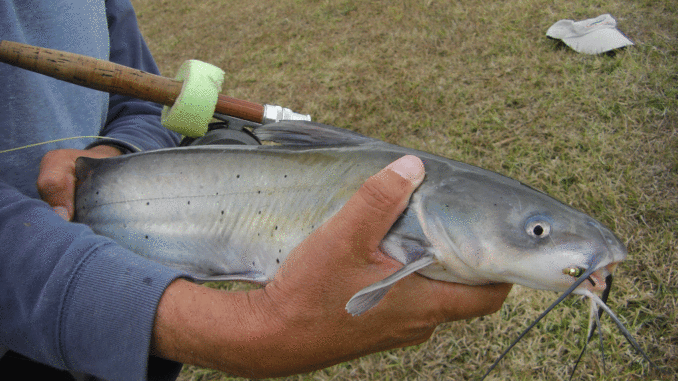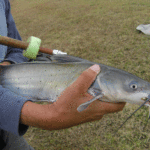
It could be a record
Strip… strip… strip.
My mind was setting the cadence for a very slow retrieve of my weighted fly. Holding to the bottom meant that any change in the slack between rod tip and water would either be fish or snag.
Suddenly the line arched out. As I slowly raised the tip of the rod, the line became taut and began to move slightly to the left.
Suspecting fish, I sharply lifted the rod 45 degrees in the air. At the same time, I loosened my finger grip on the line. Good thing, too, because as soon as I set the hook, line went buzzing off the reel!
The size of the swirls on the surface confirmed I was in an epic battle with some large denizen of the pond. With each surge, I gave it line using only the reel drag and the palm of my hand against the spool to slow it down. When it paused, I reeled down to the water and then applied lift.
Soon it came to the surface. A nice channel catfish glistened in the sun, with a black/chartreuse jitterbee stuck just inside his upper jaw.
Once I got its head just above the waterline, I was able to drag it into the bank. Victory was mine!
In general, when someone asks “What can you catch on fly?” we often point them to the Louisiana Outdoor Writers Association State Records Fly Fish Division. It lists the top 10 largest of each species registered as caught using flies and fly rod.
Catfish will readily hit a fly, but you wouldn’t know it based on the records.
Of the three recognized species of catfish in Louisiana, there’s only one entry in the Fly Fish Division (out of a possible 30). It’s Robert Well’s 23.25-pound blue caught in 1994.
In fact, most of the freshwater species have just one entry or none at all.
It’s a far different story for the saltwater category. I have a theory as to why. But first some background is in order.
Back in the mid-90s, interest in fly fishing was growing by leaps and bounds. Much of it was due to the success of “A River Runs Through It.” Or as we call it, “The Movie.”
According to outdoor writer Pete Cooper Jr., author of “Fly Fishing the Louisiana Coast,” it was the late Ed Vice who helped establish the Fly Fish Division. Vice was curator of the LOWA records list at the time, and saw a separate division as a way to grow interest in our sport.
Cooper and Bob Dennie, then-editor of Louisiana Conservationist magazine, promoted the new division to the clubs. The clubs invited Cooper, along with regional guides, to learn of the tackle, techniques and strategies for locating and landing big fish. Some clubs even spent the money to bring in saltwater fly fishing pioneers such as Lefty Kreh, Stu Apte, Nick Curcione and Jon Cave.
As knowledge and experience mushroomed, the weights in the glamour species went spiraling upward. For example, today you need a speckled trout almost 7 pounds to make that list. To take first place, you need to top Jeff Poe’s 9.31-pounder.
Redfish is more amazing. The top spot belongs to Conway Bowman, a television fishing host, whose 41.62 listing is one of two IGFA world-class records on the list.
Other salt species haven’t gone ignored. Cobia ranges from Chip Metz’s 20.19-pounder to Rob Blaine’s 57.5-pounder. Black drum ranges from Capt. Rich Waldner’s 38.0-pounder to Tom Stevenson’s 54.55-pounder, and includes two IGFA records set by Mark Markmann. Spanish mackeral ranges from Vic Tedesco’s 3.69-pounder to Dave Coignet’s 7.40-pounder.
What the current listings prove is that really big fish — saltwater fish — can be caught on the fly. And that Louisiana is perhaps the best place in the nation to do so.
So what’s holding the freshwater records back?
Traditionally, there’s been two domains in the fly world: the freshwater angler who sees it as “the quiet sport” and frequently practices catch-and-release, and the salt angler who loves competition and putting fish on ice. And never the twain shall meet!
But times are a-changing. There’s a new wave of fly anglers who straddle the middle ground. They think records are cool, as long as it doesn’t kill a fish ripe with eggs.
For anyone who might want to register their catch, there’s a few rules to keep in mind.
The fish must be caught in public waters, and by “cast and retrieve.” The class tippet must be at least 15 inches long and not more than 20 pounds test. A wire shock tippet is allowed for toothy species, but it cannot exceed 12 inches.
I usually keep a few application forms and rules pages in my tackle bag or glove compartment. Since the fish must be weighed on scales inspected by the Department of Agriculture, with two witnesses, I usually stop at a supermarket to have this done.
The fish must also be identified by a biologist from the scientific community. If you contact LDWF, they can give you a number for a qualified expert in your area.
With the form, you must also submit the rules page with each rule checked off. Also, the entire leader and fly must be submitted (I suggest putting them in a small Ziploc bag). Also, a photo showing the side of the fish from nose to tail, as well as a photo of the angler with the rod and reel used to catch the fish. I also suggest submitting a photo of the weighing showing the scale.
The filing fee is $25. It’s a small price for a piece of immortality.
Tippets
This is the month for rainbeaux trout. For anglers in the Baton Rouge area, BREC stocks several of their ponds with the coldwater species in late December. A five-weight rod and a set of woolybuggers are all you need. If action is slow, try suspending beaded flies like prince nymphs and hares ears under a small strike indicator. The limit is four per day, but please release for others to enjoy. For more details, go to www.brec.org.
Residents in North Louisiana can enjoy some great winter trout fishing of their own in neighboring Arkansas and Oklahoma. The Mountain Fork (Broken Bow, Okla.) and Little Missouri (Murfreesboro, Ark.) are tailwater fisheries nestled in the Ouachita Mountains, just 2½ hours north of Shreveport. In addition to rainbows, there are brown trout.
Our native trout — speckled trout — will be found in deeper water this month. Fishing a weighted LSU Clouser (purple/gold) off the bottom will work. But the best action will come on mild days when the fish move onto shallow flats.
It’s then that poppers and large unweighted baitfish patterns, like Whitlock Baitfish and EP’s Peanut Butter, can take large silverwonders.
January can be unpredictable for runoff. But marsh areas — such as canals off Bayou Black or Lac des Allemands — should remain clear. Good action on crappie will come on overcast days, using olive or blue/white fluff butts fished 3 feet under a strike indicator.
Upcoming Events
Jan. 20-22 – Red River Rendezvous. Bonham State Park, Bonham, Texas. This weekend retreat brings together many tiers from Texas, Louisiana, Oklahoma, Arkansas and other states to sit down and share the art of fly tying. There’s also good bank fishing on the 65-acre lake. Cost is $40 individual or $50 family, and includes two nights lodging in the group camp, plus meals. Sponsored by the Red River Fly Fishers. For more info, go to www.rrff.org.
Jan. 21 – Fly Fishing 101 clinic. Waddill Outdoors Education Center, 4141 N. Flannery, Baton Rouge. Time 8:30 a.m.–2:30 p.m. Free to the public. Pre-registration is advised as seats are limited to 30 students. Learn or improve your knowledge and skill in tackle, fly casting, fly tying, knots and leaders. Lunch and refreshments provided. Sponsored by the Red Stick Fly Fishers. For more info, or to register, contact Dugan Sabins at (225)766-4060 or go to www.rsff.org.
Feb. 6 – Dr. Ed Rizzolo Fly Tying Festival. Bethany Christian Church, 3223 Westheimer, Houston, Texas. Time 8:30 a.m.–4:30 p.m. Open to the public, families welcome. Sponsored by the Texas Fly Fishers. One of the largest fly tying shows in the country, the Houston conclave also features seminars, casting instruction, exhibitors and more. This year’s special guest is Lefty Kreh. Lunch and refreshments available. For more info, go to www.texasflyfishers.org.




